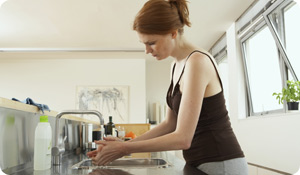
Your home may be host to all sorts of unwelcome guestsónamely germs. While you canít avoid all microbes, since young children, the elderly, and people with compromised immune systems are especially susceptible to viral and bacterial infections (like the easily transferrable staphylococcus aureus, or staph) that may not affect otherwise healthy adults, itís a good idea to try to keep your home clean, and limit your (and your loved onesí) exposure to germs.
All Around the Home
Germs commonly lurk in and around garbage cans and pet habitats. Faucets also rank high on bacteria count, as do light switches, remote controls, phones, computer keyboards and any other household items your hands (and the hands of others) routinely touch. Routine cleaning will generally keep germs at bay, though you should disinfect surfaces when someone in the household is sick.
As youíve probably guessed, the bathroom is also prime breeding ground for bacteria. "Even your toothbrush can easily become contaminated," says Catherine Passaretti, MD, infectious disease specialist at Carolinas HealthCare System in Charlotte, NC. "Especially if it is kept in close proximity to the toilet." Keep your toothbrush in a closed cabinet, and close the toilet lid before flushing to help prevent microscopic germs from toilet water vapors rising up and contaminating toothbrushes.
Food Safety and Clean Kitchens
Some common bacteria, such as salmonella, E. coli and staph, which lives in the intestinal tract and on the skin (even in healthy humans), can also be contracted from raw and undercooked foods. Although undercooked meat and other animal foods are most often associated with bacteria and foodborne illnesses, any type of food can harbor germs. So be sure to wash all fresh fruits and vegetables under running water, including those with skin or rind that will be discarded.
To kill kitchen bacteria on household surfaces, and prevent cross-contamination from food to appliance, appliance to food, or from one food to another, routinely clean your sink, dishcloths and sponges, cutting boards, countertops and refrigerator shelves, where germs that cause foodborne illness are easily spread. Hereís how to keep your kitchen surfaces and tools clean:
Cutting Boards
- Never place cooked food on an unwashed cutting board or plate that held raw animal products such as meat, poultry, seafood, or eggs.
- Clean sponges in the dishwasher; change them every two weeks.
- Wash and replace dish cloths at least every other day (or immediately if used to clean up after handling raw meat). You can throw dishcloths in the washing machine or microwave wet or damp dishcloths for three minutes (and damp sponges for one minute) to kill bacteria. Do not microwave dry towels or sponges as they may catch on fire.
- You can also soak dishcloths and sponges in the same diluted bleach solution you use to sanitize surfaces and cutting boards.
Food Safety
- Store animal products separately from other foods in the refrigerator and immediately clean up any package leaks or drips from these foods.
The Best Prevention
Other than keeping household items and surfaces as clean as possible, the single best way to prevent the spread of germs at home is to routinely wash your hands and make sure children and other family members do the same. Germs from unwashed hands easily spread to foods, drinks, toys, household appliances, and work surfaces.
The best tools for killing bacteria and preventing infection are plain soap and water, and rubbing your lathered hands together for at least 20 seconds while washing (or, for children, the amount of time it takes to sing "Happy Birthday" twice). "It doesnít matter how warm the water is," Passaretti advises. "What is important is the friction caused by rubbing." In most cases, you donít need antibacterial soap to do the job, but you can use an alcohol-based hand cleaner containing at least 60% alcohol if soap and water are not available. "But sanitizer residue can build up on hands," Passaretti adds. "So if used repeatedly, it is important to wash your hands with soap and water after every four or five uses."
It is especially important to wash your hands:
- Before and after handling food.
- After touching any type of garbage.
- After using the bathroom.
- After being in contact with someone who is sick.
- After touching doorknobs, handles, light switches, or anything else that is handled often by different people.
Catherine Passaretti, MD, reviewed this article.
Sources
Passaretti, Catherine, MD. Email to author. January 7, 2015.
Burton M., E. Cobb, P. Donachie, G. Judah, V. Curtis and W.P. Schmidt. "The Effect of Handwashing with Water or Soap on Bacterial Contamination of Hands." International Journal of Environmental Research and Public Health 2011 8(1):97-104. doi: 10.3390/ijerph8010097
"An Ounce of Prevention Keeps the Germs Away: Seven Keys to a Safer Healthier Home." Centers for Disease Control and Prevention. Accessed January 20, 2015.
Hoyle, E. and P. Schmutz. "The Clean Kitchen Test." Clemson Cooperative Extension. Revised July 2011. Accessed January 28, 2015.
"The Latest in Kitchen Sanitation Issues." University of Arizona Cooperative Extension. Revised May 2008. Accessed January 28, 2015.
"Interim Guidance on Environmental Management of Pandemic Influenza Virus." Flu.gov. Page accessed February 2, 2015.





